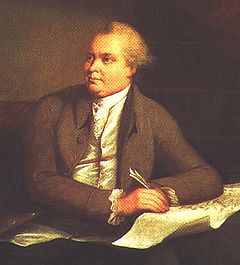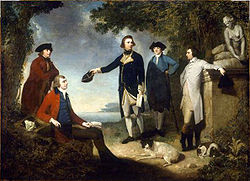- Daniel Solander
-
Daniel Solander 
Born February 19, 1733
Piteå, Norrland, SwedenDied May 13, 1782 (aged 49)
LondonResidence Sweden and England Nationality Swedish Fields Botany
ZoologyAlma mater Uppsala University Author abbreviation (botany) Sol. Daniel Carlsson Solander or Daniel Charles Solander (19 February 1733 – 13 May 1782) was a Swedish naturalist and an apostle of Carl Linnaeus.[1] Solander was the first university educated scientist to set foot on Australian soil.
Contents
Biography
Solander was born in Piteå, Norrland, Sweden, to Rev. Carl Solander[1] a Lutheran principal, and Magdalena née Bostadia.[1] Solander enrolled at Uppsala University in July 1750 and studied languages and the humanities. The professor of botany was the celebrated Carolus Linnaeus who was soon impressed by young Solander's ability and accordingly persuaded his father to let him study natural history. Solander traveled to England in June 1760 to promote the new Linnean system of classification. He was an assistant librarian at the British Museum from 1763 onwards, and elected as Fellow of the Royal Society in the following year. Afterwards he held the position of Keeper of Printed Books at the British Museum.
Dr Daniel Solander, Sir Joseph Banks, Captain James Cook, Dr John Hawkesworth and Earl Sandwich by John Hamilton Mortimer.[2] Use a cursor to see who is who.[3]
In 1768 Solander and his assistant Herman Spöring were employed by Joseph Banks, to join him on James Cook's first voyage to the Pacific Ocean on board the Endeavour. They were the botanists who inspired the name Botanist Bay (which later became Botany Bay) for the first landing place of Cook's expedition in Australia. Solander helped make and describe an important collection of Australian plants while the Endeavour was beached at the site of present-day Cooktown for nearly 7 weeks, after being damaged on the Great Barrier Reef. These collections later formed the basis of Banks' Florilegium.
On their return in 1771 Solander became Banks's secretary and librarian and lived in his house at Soho Square. In 1772 he accompanied Banks on his voyage to Iceland, the Faroes and the Orkney Islands. Between 1773 and 1782 he was Keeper of the Natural History Department of the British Museum. In 1773 he was elected a foreign member of the Royal Swedish Academy of Sciences.
Solander invented the book-form box known as the Solander box which is still used in libraries and archives as the most suitable way of storing prints, drawings, herbarium materials and some manuscripts.
Solander died at Banks' home in Soho Square of a stroke, aged 49, at 9.30pm on 13 May 1782. An autopsy was performed the next day, and revealed a brain haemorrhage.[4]
Legacy
It has been claimed that Solander deserves a great deal more recognition than he has received, and that he was denied his legacy by the high standing of Banks, who treated Solander, and Jonas Dryander before him, as his servants rather than as botanists of equal standing to others in the botanical establishment. The treatment and recognition of these two stands in contrast to that of Robert Brown, the third in the succession of Banks' botanists, who was feted as the pre-eminent botanist of his day. This contrast could be due to the fact that Brown was British, whereas the others were foreigners; or because Banks was already in decline by the time he employed Brown.[5]
Solander Gardens in the east end of London is named after him, as are the Solander Islands off New Zealand's South Island. One of the many plants named in his honour is Nothofagus solandri. Solander was associated with Banks in Illustrations of the Botany of Captain Cook's Voyage Round the World, and his The Natural History of Many Curious and Uncommon Zoophytes, Collected by the late John Ellis, (1786) was published posthumously.
In Solander's birth town Piteå the Solander Science Park houses a number of cleantech companies and research organizations.[6]
See also
- European and American voyages of scientific exploration
References
- ^ a b c Gilbert, L. A. (1967). "Solander, Daniel (1733 - 1782)". Australian Dictionary of Biography. 2. Canberra: Australian National University. http://www.adb.online.anu.edu.au/biogs/A020421b.htm. Retrieved 2010-02-25.
- ^ Digital Collection, National Library of Australia
- ^ Catalogue, National Library of Australia, accessed February 2010
- ^ [1]
- ^ Barker, R. M. and Barker, W. R. (1990). "Botanical contributions overlooked: the role and recognition of collectors, horticulturists, explorers and others in the early documentation of the Australian flora". In Short, P. S. (ed.). History of systematic botany in Australia. Australian Systematic Botany Society. pp. 37–86. ISBN 0-7316-8463-X.
- ^ Solander Science Park website
- ^ "Author Query". International Plant Names Index. http://www.ipni.org/ipni/authorsearchpage.do.
- Edward Duyker 1998. Nature's Argonaut: Daniel Solander 1733-1782: Naturalist and Voyager with Cook and Banks. Melbourne University Press. ISBN 0-522-84753-6
- Royal Society Archive entry on Solander
- Serle, Percival (1949). "Solander, Daniel Charles". Dictionary of Australian Biography. Sydney: Angus and Robertson. http://gutenberg.net.au/dictbiog/0-dict-biogSa-Sp.html#solander1.
- Duyker, Edward & Tingbrand, Per (ed. & trans) 1995, Daniel Solander: Collected Correspondence 1753—1782, Melbourne University Press, Melbourne, 1995, pp. 466, ISBN 0-522-84636-X Scandinavian University Press, Oslo, 1995, pp. 466, ISBN 82-00-22454-6
External links
 "Solander, Daniel Charles". Dictionary of National Biography. London: Smith, Elder & Co. 1885–1900.
"Solander, Daniel Charles". Dictionary of National Biography. London: Smith, Elder & Co. 1885–1900.- Daniel Solander biography on the website of his home town Piteå
- The Solander Society
- Nature's Argonaut
- Daniel Solander
- The natural history of many curious and uncommon zoophytes : collected ... by the late John Ellis ... Systematically arranged and described by the late Daniel Solander .. (1786) downloadable text at Open Library
- Ojebyn pictures, Daniel Solander's hometown
Categories:- Botanists with author abbreviations
- Australian people of Swedish descent
- Botanists active in Australia
- People associated with the British Museum
- Fellows of the Royal Society
- Members of the Royal Swedish Academy of Sciences
- People from Piteå
- Swedish librarians
- Uppsala University alumni
- Swedish botanists
- Swedish phycologists
- 1733 births
- 1782 deaths
- Employees of the Natural History Museum
Wikimedia Foundation. 2010.

